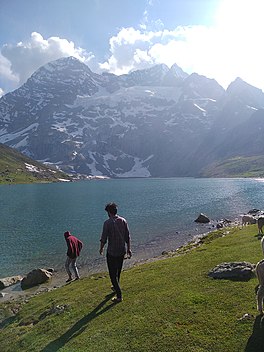
Triyuginarayan Temple is a Hindu temple located in the Triyuginarayan village in Rudraprayag district, Uttarakhand, India. The ancient temple is dedicated to god Vishnu. Its fame is credited to the legend of god Shiva’s marriage to goddess Parvati witnessed by Vishnu at this venue and is thus a popular Hindu pilgrimage sites. A special feature of this temple is a perpetual fire, that burns in front of the temple. The flame is believed to burn from the times of the divine marriage. Thus, the temple is also known as Akhand Dhuni temple.

Ganderbal is a town and a municipality committee in Ganderbal district in the Indian union territory of Jammu and Kashmir. It is the headquarters of Ganderbal district.It is in Central Kashmir, it has an average elevation of 1,619 metres. It is bordered by district Srinagar in the south, Bandipore to the north, Kargil in the northeast, Anantnag to the south-east and Baramulla in the south-west.The current District Magistrate of Ganderbal is Mr. Shyambir Singh.District Ganderbal is known for its beauty,there are many beautiful places in Ganderbal.Sonmarg is the most famous place in Ganderbal, Shri Amarnath Ji Yatra is also done in Ganderbal.

Sonamarg or Sonmarg, known as Sonamarag in Kashmiri, is a hill station located in the Ganderbal District of Jammu and Kashmir, India. It is located about 62 kilometers from Ganderbal Town and 80 kilometres (50 mi) northeast of the capital city, Srinagar.

Jammu and Kashmir is home to several valleys such as the Kashmir Valley, Chenab Valley, Sindh Valley and Lidder Valley. Some major tourist attractions in Jammu and Kashmir are Srinagar, with its renowned Dal Lake and Mughal Gardens, Gulmarg, Pahalgam, Bhaderwah, Patnitop and Jammu. Every year, thousands of Hindu pilgrims visit holy shrines of Vaishno Devi and Amarnath which has had a significant impact on the state's economy.
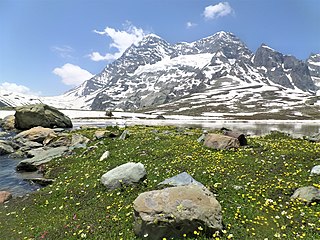
Mt Harmukh is a mountain with a peak elevation of 5,142 metres (16,870 ft), in Ganderbal district of Jammu and Kashmir in India. Harmukh is part of the Himalayas Range and is located between Sind River in the south and Kishanganga River in the north, rising above Gangabal Lake in the vicinity of Kashmir valley. It is mostly climbed from the northwestern side of Arin, via Kudara, Bandipore. Harmukh is considered sacred in Hinduism.

The Ganderbal district, or more formally District Ganderdal, is an administrative district of Indian-administered Jammu and Kashmir in the disputed Kashmir region. Ganderbal town is administrative headquarters of district. It was formed in 2007 and has 6 subdistricts (tehsils): Kangan, Ganderbal, Tullamulla, Wakura, Lar, and Gund.
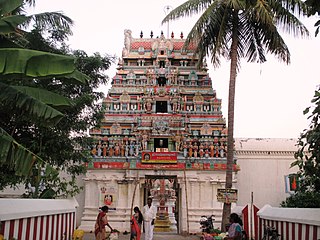
Nathan Kovil or Thiru Nandipura Vinnagaram Temple in Nathan Kovil, a village in the outskirts of Kumbakonam in the South Indian state of Tamil Nadu, is dedicated to the Hindu god Vishnu. Constructed in the Dravidian style of architecture, the temple is glorified in the Nalayira Divya Prabandham, the early medieval Tamil canon of the Alvar saints from the 6th–9th centuries CE. It is one of the 108 Divya Desams dedicated to Vishnu, who is worshipped as Jagannathan and his consort Lakshmi as Shenbagavalli.
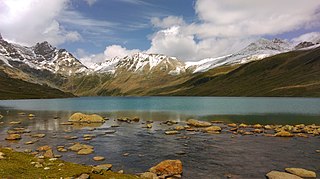
The Gangabal Lake, also called Haramukh Ganga, is an alpine high-altitude oligotrophic lake situated at the foot of Mount Haramukh in the Ganderbal district of Jammu and Kashmir, India. The lake has a maximum length of 2.5 kilometres (1.6 mi) and maximum width of 1 kilometre (0.62 mi). It is fed by precipitation, glaciers and springs and is home to many species of fish, including the brown trout. Water from the lake outflows into the nearby Nundkol Lake and then into the Sind River via Wangath Nallah. This lake is considered sacred in Hinduism as one of the abodes of Shiva, and Kashmiri Hindus perform an annual pilgrimage to the lake called Harmukh-Gangabal Yatra.

The Sind River or the Sindh River is a river in the Ganderbal district of the union territory of Jammu and Kashmir, India. It is a major tributary of the Jhelum River and is 108 km (67 mi) long.

The Gadsar Lake, also called Yemsar, is an alpine high altitude oligotrophic lake in the Ganderbal district of Kashmir Division in Jammu and Kashmir, India. It has an elevation of 3,600 metres (11,800 ft), a maximum length of 0.85 km and maximum width of 0.76 km.
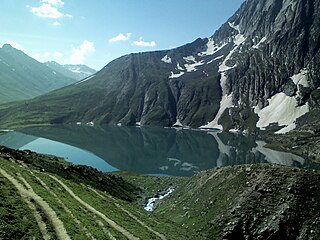
The Vishansar Lake is an alpine high-elevation oligotrophic lake, situated near Sonamarg in the Ganderbal district of Jammu and Kashmir, India, at an elevation of 3,710 metres (12,170 ft). It has a maximum length of 1 km, and maximum width of 0.6 km.
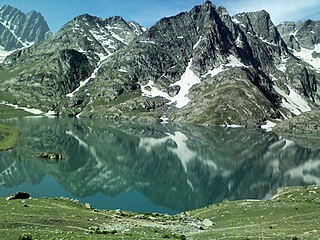
The Krishansar Lake is an alpine high elevation oligotrophic lake situated near Sonamarg, in the Ganderbal district of Jammu and Kashmir in India at an elevation of 3,710 metres (12,170 ft). It is located less than one kilometer northwest of Vishansar Lake, and has a maximum length of 0.95 km and maximum width of 0.6 km.
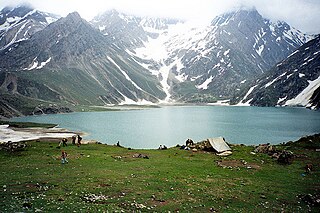
Sheshnag Lake is an alpine high elevation oligotrophic lake located in Anantnag district of Kashmir Valley in Jammu and Kashmir, India at an elevation of 3590 meters. It is situated on the track leading to the Amarnath cave, about 23 km from Pahalgam. It has a maximum length of 1.1 km and maximum width of 0.7 km.

Naranag or (Nara Nag) is a tourist village and ancient Hindu pilgrimage site, near Ganderbal town in the Ganderbal district of the Kashmir Valley in Jammu and Kashmir, India. Well known for its ancient but pillaged temple ruins complex, it is located around 8 km from Kangan, 6 km upstream from the Sind River. Noted for its scenic meadows, lakes and mountains, it is a base camp for trekking to the Mount Haramukh 16,870 ft and Gangabal Lake. The village lies at the left bank of the Wangath river, which is a tributary of the Sind River. Tourism hut at Naranag for any information and assistance tourism officials are available and hut is also provide for accommodation.
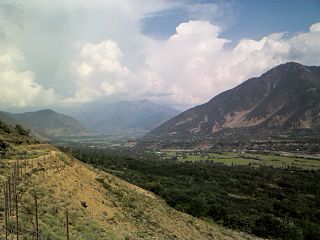
The Sind Valley is a Himalayan sub-valley of the Kashmir Valley in the Indian union territory of Jammu and Kashmir. The entrance of the Sind Valley lies 33 kilometres (21 mi) northeast of Srinagar the capital of Jammu and Kashmir. It is a 65 kilometres (40 mi) long gorge valley with an average width of 1 kilometre (0.62 mi).

The Tarsar Lake or Tar Sar is an almond-shaped, oligotrophic alpine lake situated in the Anantnag district of Jammu and Kashmir, India. On its west side lies Dachigam National Park, and on its south side lies Tral. The shortest route for reaching it, is from Surfraw Ganderbal, but it has a difficult terrain. Other trek routes to the lake are from Lidderwat and Nagaberan forest areas which fall in south Kashmir.
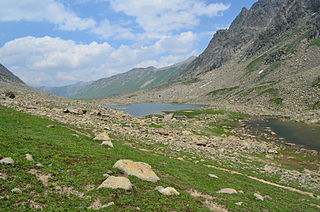
The Satsar Lake or Sat Sar consists of seven small alpine lakes situated in Ganderbal district of the Kashmir Valley in Jammu and Kashmir, India.
Wangath Temple complex is a group of Hindu temple monuments in Wangath, close to Naranag, in the Ganderbal district of the Kashmir Valley of Jammu and Kashmir, India. Wangath is a village located around 48 miles (77 km) northeast of Srinagar. The current structure was built by Lalitaditya Muktapida of the Karkota dynasty in the 8th century CE.
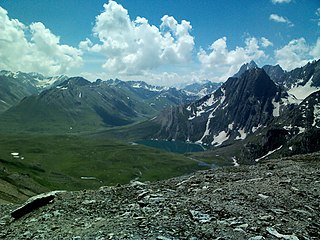
The Great Lakes Trek or Kashmir Great Lakes Trek commercially known as Sonamarg-Vishansar-Naranag Trek is an alpine himalayan high-altitude trek in the Kashmir Valley in the Indian state of Jammu and Kashmir. This is the most famous trek in Kashmir. The trek is usually completed in 6-7 days and is rated as moderate-difficult in terms of terrain and trail difficulty. The trek is an absolute treat and worth every effort as one gets to see new alpine lakes, mountain peaks, passes, meadows and glaciers almost every subsequent day.
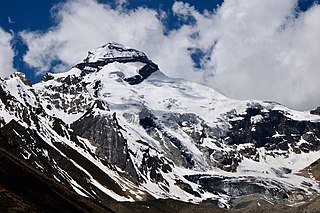
Adi Kailash, also known as Shiva Kailash, Chota Kailash, Baba Kailash or Jonglingkong Peak, is a mountain located in the Himalayan mountain range in the Pithoragarh district of Uttarakhand, India. It is the second most important peak among the group of five separate peaks in Himalayas in separate locations collectively known as the Panch Kailash or "Five Kailashas", other being Mount Kailash in first place, Shikhar Kailash in third, Kinnaur Kailash in fourth and Manimahesh Kailash in fifth place in terms of importance. Gauri Kund and Parvati Tal glacial lakes are at the base of the Adi Parvat. Adi Kailash & Limpiyadhura Pass are both located northwest of Gunji. The Lipulekh Pass, Old Lipulekh Peak & Om Parvat are located northeast of Gunji. Adi Kailash base camp, near the Hindu Shiva temple on the banks of sacred Jolingkong Lake, is located 17 km northwest of Kuthi (Kuti) village in Kuthi Yankti Valley. The Adi Kailash Yatra Circuit route-1 via Gunji, the eastern-southeastern route, is reached by the Pithoragagh-Lipulekh Pass Highway (PLPH) and its Gunji-Lampiya Dhura Pass Road (GLDPR) paved motorable spur via Kuthi Yankti Valley from Gunji to Adi Kailash. The permits for this route are issued at Dharchula and medical check-up is conducted there. The homestay accommodation is available in the villages along the route in Gunji, Napalachchu, Nabhi, Juli Kong and Kuti. The Adi Kailash Yatra Circuit route-2 via Darma Valley, the western-southwestern route, begins by going up the Darma Valley and then crossing the Sin La pass south of Brahma Parvat to go to Kuthi Yankti Valley to Jolingkong Lake Base Camp. Many travellers who take the route-2, after the Adi Kailash darshan chose to traverse the route-1 in reverse direction till Gunji where they can join the Om Parvat & Mount Kailash-Lake Manasarovar Tibetan pilgrimage route along the Sharda River. Kailash-Mansarovar, Adi Kailash and Om Parvat are sacred to Hindus.
